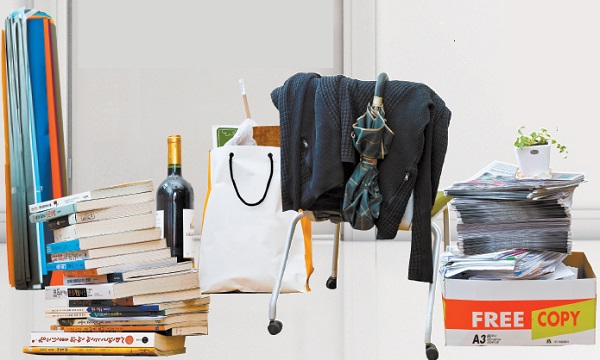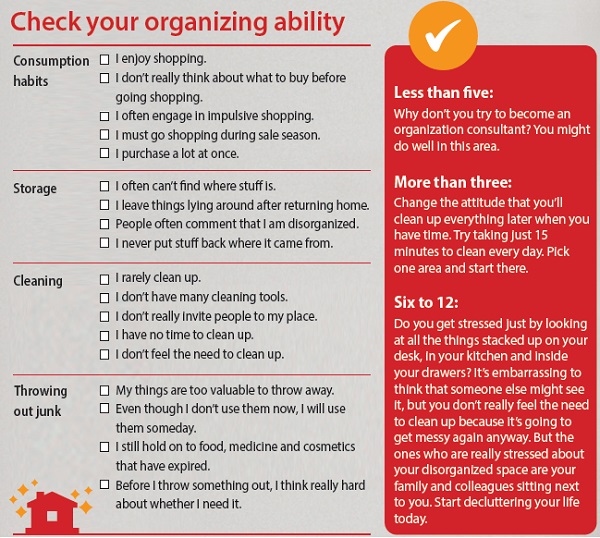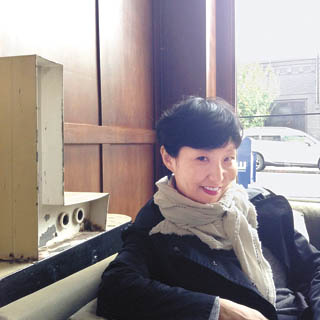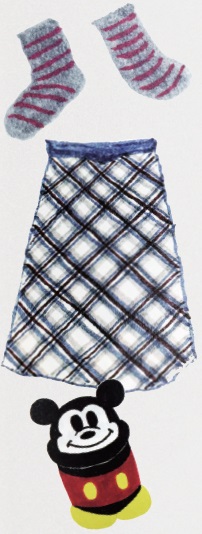Bringing order to your life, one old sock at a time

In an online community titled “Ability to Organize: The Power of 15-Minute Cleaning” on Naver, scores of users who love to clean up and organize their rooms and houses share their know-how. Children’s book writer Seon Hyun-kyung said she changed her life through a project she started in which she throws away one thing per day.
And Kim Yeon-hee, 40, shared what she threw away every day for a month through an online community, saying it was “distressing to always see objects stacked up everywhere on my office desk, such that it even decreased my work efficiency.” But Kim said she couldn’t throw them away as she worried she would feel anxious that she would need them again someday.
“But when I did it, I felt so much better. It was good riddance,” Kim said. “I couldn’t have done it on my own for the whole month, but because I told people about it ... I was able to keep it up.”
For those who suffer from excessive acquisition of objects, and the inability or unwillingness to discard them, which when severe is characterized as compulsive hoarding behavior, it is possible to learn to enjoy throwing things away.
The first step

“I thought I could throw away a pair of socks,” she said. “Because they are not that memorable of an object, I thought I could throw them away quite easily.”
Thus Seon began the “Throwing One Thing Out a Day” project on April 22, 2013, with a pair of black socks. Every day for a year she tossed out one object that was lying around her home. For the first week, she only discarded socks.
“As I saw myself, who couldn’t even throw away anything, throwing away a pair of socks that I don’t wear everyday, I started to feel some sort of pleasure,” she said.

Children’s book writer Seon Hyun-kyung turned from a hoarder into an organizer by starting the “Throwing One Thing Out a Day” project. Last year, she even published a book on how she overcame hoarding. [JOONGANG ILBO]
“I kept everything. If I received a gift, I not only kept the gift but also the box, the wrapping paper plus the ribbon,” she said. “Anything that I believe seems usable, I kept it. I’d never thrown away old socks or underwear unless I couldn’t wear them.”
Then one day, a friend of Seon recommended that she watch a documentary titled “Hoarders, Those Who Can Never Throw Away.” The documentary dealt with compulsive hoarders who are obsessed with acquiring and collecting objects but never get rid of anything. They bring things home and stack them up but never get rid of anything, so after a while their homes start to look like a junk shop.
Watching the documentary on TV, Seon was shocked to realize that her house looked similar to the ones featured on the program.
“Books, toys and clothes were everywhere, such that my house looked like it was about to burst,” she said. “But no matter how hard I looked, there was nothing I could discard. I felt like I would miss it if I threw it away, and that I would need it one day. Then I realized that I’d been seeking stability from these objects that I don’t even need.”

Seon says it was easier for her to throw out the things she doesn’t use anymore by writing about them and drawing pictures of them in her diary. It was a sort of “ritual,” she said, to keep the memory but get rid of the object. [SEON HYUN-KYUNG]
Because she couldn’t throw away an intact object, she began to wear the disused socks. For the ones she thought she would never wear, she began to write about them in her diary and draw pictures of them. She believed she wasn’t able to throw the socks out because she couldn’t let go of the memories of them, and by keeping a record of them in words and pictures, she thought it might be easier for her to let them go.
“It felt like I could easily throw them out by writing about them and drawing them on paper,” she explained. “It’s some sort of goodbye ritual for me to get myself sorted.”
As Seon continued to gather up things to get rid of, she would first use the items for a couple of days. The purpose was to make it easier to give them away to anyone who showed interest in the items - whether it was a bag, shoes, a sweater or anything else.

She also organized a small private flee market with her friends by collecting all the unwanted items from her home, and donated the things that did not get sold to the Beautiful Store, an organization that takes donations of new and used articles for resale at low prices to support needy communities. Through the flee market, Seon and her friends earned 1.2 million won ($1,000), which they donated to an organization that helps stray cats.
As time went by, Seon began to witness changes in her consumption habits as well.
“Every time I went shopping, I kept on asking myself if I was buying something that I was just going to throw out one day,” she said. “My habit of impulsive buying decreased dramatically, and I began to look for articles that are more durable, that would last a long time.”
The writer’s family’s habits also changed. Seon’s husband and daughter, who initially had their guards up, anxious that Seon would throw out their things, now ask Seon before purchasing things, and their consumption gradually decreased.
What began with discarding old socks spread to all the glass bottles that filled her cupboard, uneaten pickles in her refrigerator, an old leather hat she bought her husband many years ago, and even a backpack she used to wear often 20 years ago while studying in Canada. She realized that together with her stuff, she was also decluttering her thoughts and getting rid of unnecessary emotions.
“I threw out the relationship with an acquaintance that was concerning me for a while and the arrogance I had in thinking that I was still young,” Seon said, chuckling. “It’s like magic. These thoughts and feelings are not like objects that disappear from your sight once you throw them out, but I found that they gradually die out.”
Seon collected all the writings and drawings of the things she threw out over the course of a year and published a book last year titled “Throwing One Thing Out a Day.” Seon is still continuing the project.
Last month, the writer and her family moved to Portland in the United States and plan to stay there for about a year and a half.
“I began to think whether I was staying in one place for too long and only increasing my stuff at home,” said Seon. “By having a house and putting stuff in there, I guess I found myself settling down for the present and being satisfied. But what I didn’t know was that all the things I’ve stacked up in my house were actually grabbing onto my legs, making me unable to take a step forward. By throwing away a thing a day, I believe the weight you feel on your shoulders will feel lighter as well.”
Getting organized
Modern society incites consumption. The size of shopping carts at large supermarkets increased more than two times, from 80 liters (21 gallons) in the 1980s to 180 liters today. According to futurologist Martin Lindstrom, doubling the size of shopping carts leads shoppers to purchase 30 percent more goods.
Together with the diversifying methods of consumption, ranging from social commerce, online shopping, home shopping to various delivery services, the number of unused items is also increasing in many households today. Affordable fast fashion brands make it easy for the fashion conscious to stock up on cheap, low-quality clothes.
Organization consultant Yoon Seon-hyun, who runs the Very Good Organizing consulting firm, said that when she visits homes for consultation, “70 percent of the things at home are not being used on average, at least 30 to 50 percent of them are things that can be discarded right away.”
According to organization experts, people who find it difficult to throw things away feel that way because they feel like they are chucking cash in the bin, but Yoon explained that any product loses at least more than half of its value once it’s been purchased and opened for use. So unless your clutter happens to be a painting by a famous artist or a luxury good, it is just a near-worthless, second-hand item.
Nevertheless, people tend to over-value their things. Experts say it’s because of the memories people associate with their stuff. But objects are just objects. Throwing them away doesn’t mean you are throwing away the memory as well.
Another obstacle that makes people hesitate to throw things away is the thought that they’ll need it someday. But experts say that “someday” never comes.
Most likely people today inherited this habit from their parent’s generation, who lived through war and famine. They feel it is necessary to keep things around and horde supplies and educated their children to do the same. But by throwing things away, experts say you not only feel emotionally refreshed, but you will also be able to enjoy the a more spacious living area.
Yoon offered some tips to start organizing your home if you think you might be a hoarder. If you don’t know where to begin, look around and pick out what you have the most of. The things you have the most of should the first to go.
Han Ji-hyun, 45, who has been throwing out three things a day said, “I used to purchase pretty plates and cups whenever I saw them because I like them so much.” So when she began to get rid of excess clutter, she started with the plates.
“After getting rid of all the unused plates and cups, I never bought another one even though they look so pretty, as I know that I will not keep them,” she said.
Yoon says the first step in throwing out is organizing. Start by dividing up the things to throw out, give away, resell, recycle and repair. There has to be a standard for the things you should put in the bin. According organizing consultant and best-selling author Marie Kondo, throw away the things that don’t give you joy. She said that things that don’t move you are not necessary, comfortable or even convenient.
This should include clothes that you haven’t worn for more than a year, food that has passed its expiration date, an unnecessary number of socks and uncomfortable clothes you don’t wear often. If throwing these out still terrifies you, Yoon recommends making a temporary box.
“In that box, you can write a note saying that you’ll keep these things for three months, or six months or a maximum of nine months,” she said. “Then if you still haven’t used the things in that box, you have to tell yourself to let them go. It means that ‘Someday I’ll need it’ will never come.”
The most “beautiful way” to get rid of your things is to donate or resell. The Beautiful Store (www.beautifulstore.org) and Goodwill (www.goodwillsongpa.org) accept donated goods and acknowledge them as donations so you can them to your year-end tax adjustment.
But according to Jeon Seung-hee, manager of the Beautiful Store’s PR team, you should think about what might be useful to others before donating.
“Even though it is valuable to you, think about whether it will be useful for the others,” she said. “If the items have cracks or if they are broken, we can’t sell them.”
In that case, the bin might be best.
BY SONG JEONG [sharon@joongang.co.kr]










with the Korea JoongAng Daily
To write comments, please log in to one of the accounts.
Standards Board Policy (0/250자)